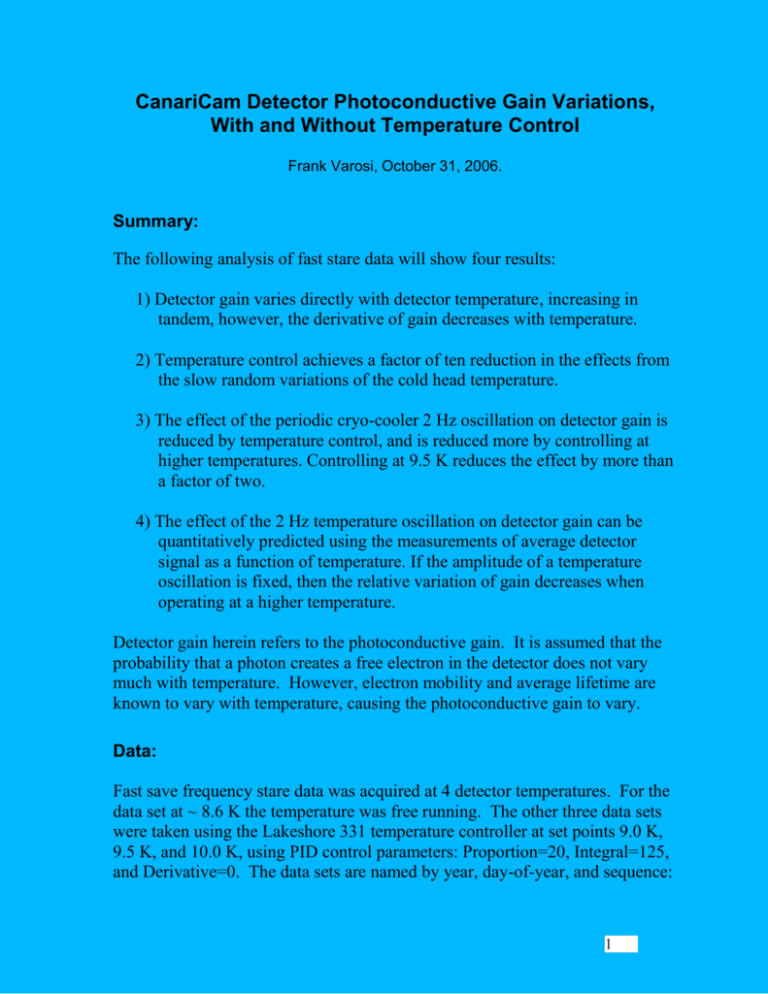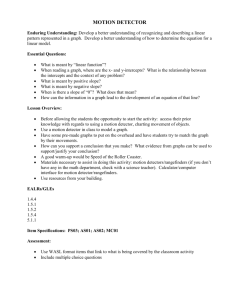CanariCam Detector Photoconductive Gain Variations, With and
advertisement

CanariCam Detector Photoconductive Gain Variations, With and Without Temperature Control Frank Varosi, October 31, 2006. Summary: The following analysis of fast stare data will show four results: 1) Detector gain varies directly with detector temperature, increasing in tandem, however, the derivative of gain decreases with temperature. 2) Temperature control achieves a factor of ten reduction in the effects from the slow random variations of the cold head temperature. 3) The effect of the periodic cryo-cooler 2 Hz oscillation on detector gain is reduced by temperature control, and is reduced more by controlling at higher temperatures. Controlling at 9.5 K reduces the effect by more than a factor of two. 4) The effect of the 2 Hz temperature oscillation on detector gain can be quantitatively predicted using the measurements of average detector signal as a function of temperature. If the amplitude of a temperature oscillation is fixed, then the relative variation of gain decreases when operating at a higher temperature. Detector gain herein refers to the photoconductive gain. It is assumed that the probability that a photon creates a free electron in the detector does not vary much with temperature. However, electron mobility and average lifetime are known to vary with temperature, causing the photoconductive gain to vary. Data: Fast save frequency stare data was acquired at 4 detector temperatures. For the data set at ~ 8.6 K the temperature was free running. The other three data sets were taken using the Lakeshore 331 temperature controller at set points 9.0 K, 9.5 K, and 10.0 K, using PID control parameters: Proportion=20, Integral=125, and Derivative=0. The data sets are named by year, day-of-year, and sequence: 1 CC2006-250-003.fits CC2006-250-004.fits CC2006-250-006.fits CC2006-254-002.fits at 10.0 K at 9.5 K at 9.0 K at 8.6 K (controlled) (controlled) (controlled) (free running, no temperature control) CanariCam was pointed ZnSe window up, with Si1-7.8um filter in optical path and everything else open. For each dataset 1022 frames were acquired with four-point-sampling (S1R3) at a save frequency of 6.4 Hz over a period of 2.2 minutes. The MCE frame time was 26 ms, so 5 MCE frames were co-added for each saved frame. One MCE frame (26ms) is discarded after each save-set of 5 co-adds, so the samples are slightly separated. The bias voltage applied to detector grooves that controls sensitivity was set to V_detgrv = -6.5 V, a nominal operating value (max is about -7 V). Note that the data set at 8.6 K was taken on day 254, because the data taken on day 250 was either incomplete or accidentally deleted. Unfortunately, on day 254, a can painted black was above the window that was not noticed, so the intensity of radiation was not exactly the same as on day 250 when window was viewing just the room. But in all cases we assume that the variation of radiation intensity entering the window is negligible compared to effects of internal variations. The data support that assumption, and previous data taken when the window was pointed downward also give similar results, however the detector temperature does not vary as much when window is pointed downward. Sideways pointing variations are about the same as for upward pointing. Data was also acquired on day 2006-248 when the camera window was pointed downward and V_detgrv = -5.8 V, but using the Si3-9.8um filter. At lower V_detgrv the detector array is less sensitive so the 9.8um filter was used to keep the signal in the same range (the photon flux from the room is about a factor of two larger at 9.8um than 7.8um). CC2006-248-001.fits CC2006-248-002.fits CC2006-248-003.fits CC2006-248-004.fits at 7.9 K at 8.0 K at 9.0 K at 10.0 K (no temperature control) (controlled) (controlled) (controlled) With the window downward the detector mount is about 0.7 K colder.Analysis: 2 The average (mean) value was computed for each saved frame and divided by 5 (co-adds), giving a time series of frame mean values in basic units of ADU per frame time (Analog to Digital Converter Units, 16 bit range). For each data set, the average value of all the frame mean values was calculated and subtracted from the time series, giving the variation around the global average. Each mean value variation time series was analyzed by discrete Fourier transform (FFT). The absolute value of the amplitudes are divided by the global average of each data set and plotted versus frequency: 3 Plotting the amplitude as a fraction of global average allows simple comparison of variations independent of changing global average signal. The global average value is in the title of each plot, as well as the detector temperature. The global average signal increases with detector temperature (ignoring 8.6K data), as shown in the following graph. Plotted with the data from day 250 is the data from day 248 taken with the 9.8 um filter and V_detgrv = -5.8 V. The detector is less sensitive at -5.8 V, but there are more thermal photons from the room at 9.8 um, so the two sets of data fall in the same range of ADUs. 4 The solid curves in the above graph are second-degree polynomial (parabolic) function fits to the data points, as a function of detector temperature. Note that the partial derivative of signal with respect to temperature decreases as the temperature increases. The Fourier spectrum amplitudes shown in all the previous plots should be multiplied by a factor of two, because just the one-sided results from the FFT were used. Normally the two-sided FFT results should be used. Since for real functions the amplitudes at negative frequencies equal the conjugate of the amplitudes at positive frequencies, the full power at each frequency would be the sum of positive and negative frequency amplitudes, thus equivalent to a factor of two times the one-sided spectrum. For comparing in relative sense this factor does not matter, but when comparing in absolute sense the missing factor of two will be applied and noted as such. Additionally, because the data was acquired in normal co-adding mode, the saved data is actually the result of a moving average applied to what would have been 26 ms frame samples if co-adding was not performed. The MCE has a special mode to bypass co-adding (called SIM=8) and that mode will be used in future measurements of this kind so as to acquire actual 26 ms samples, separated by 5 * 26 ms gaps. The effect of the moving average is equivalent to a low pass filter applied to the samples. To approximately recover the true data variation the spectral amplitudes need to be multiplied by the inverse of the low pass filter, which at 2 Hz is a factor of 1.1, and at 4 Hz is a factor of 1.5 (at 1 Hz the factor is essential unity). 5 Conclusions: Since the input radiation was constant, it follows that the gain of the camera system must increase with temperature, as shown in the plot of average signal versus detector temperature for the two cases of groove bias voltages. The data points are fit well by parabolic curves, but more data points are needed to verify the true functional form. Most likely it is the product of electron mobility, , and average lifetime, , in the detector material that increases with temperature, thereby increasing the photoconductive gain factor G, G=E/d where E is the electric field across the detector material of size d, created by the groove bias voltage (normally set so that G < 1). The resulting current I, created by a photon flux P incident on an area A is I = e G P A where is the quantum efficiency of the detector material, the probability that a photon will create an electron (of charge e). The measured signal S is then proportional to the current I, by factors of integration capacitance and frame time, multiplexer gain (~0.65), and preamplifier gain (~3). The Fourier spectrum plots show that the frame mean value spectra have an inverse frequency (1/f) functional behavior, typical of weak random processes such as Brownian motion and the stock market. For the case of no temperature control at 8.6 K the 1/f amplitude spectrum extends to 2 Hz. The spectrum beyond 2 Hz is aliased from above the Nyquist frequency of 3.22 Hz. Each data set also shows a periodic variation at 2 Hz due to the cyro-cooler mechanism. The second smaller peak is an alias of the 4 Hz harmonic, showing up at 2.44 Hz (4 - 3.22 = 3.22 - 2.44). Chopping at 1 Hz or faster would cancel out most of the signal variations, but the variation at 2 Hz would still pose a problem. To get the peak-to-peak variation that may show up in the chopped difference of data, the amplitude at 2 Hz should be multiplied by a factor of 4.4 (factor of 2 to get from one to two-sided FFT, another 2 to get peak-to-peak, and 1.1 to correct for low pass filter): so 6e-5 of 22841 ADU times 4.4 gives about 5.5 ADU peak-to-peak worst-case error. 6 The following graph shows the spectra for 9.5 K and 8.6 K data plotted together. Controlling the temperature at 9.5 K reduces the 1/f variations by about an order of magnitude (factor of 10). Controlling at 9 K or 10 K yields about the same order of magnitude squelching of 1/f variations. 7 The reduction in the effect of the 2 Hz temperature oscillation improves with higher control set point temperature, as shown in the following plot of spectra from the four data sets: the 8.6 K (no control) relative amplitudes are stars, the 9.0 K data are diamonds, the 9.5 K data are triangles, and 10.0 K data are squares. The exact frequency of the oscillation is about 2.003 Hz, and the amplitude decreases with increasing temperature set point. Controlling the detector temperature at 9.5 K reduces the effect on detector signal (gain) variation by better than a factor of two (approximately 2.3). 8 The next plot shows the same data with logarithmic scaling for the vertical axis of spectral amplitude divided by average signal. It is apparent that fluctuations of frequencies around 2 Hz are reduced more by turning on the temperature control than the fluctuation at 2 Hz. Most likely the LakeShore 331 controller is not able to eliminate the 2 Hz temperature oscillation completely, or either the PID parameters used will not control such an oscillation. However, the PID control parameters work well over the whole spectrum. 9 The amount of reduction in the 2 Hz signal (gain) fluctuations as detector temperature increases can be predicted as follows. The relative signal fluctuation in terms of the variation with detector temperature is: G S T S T 2 2 S G S S T 2 S T 2 From the plot of average signal versus temperature, it is apparent that the derivative of S with respect to T decreases as T increases, and so if T is fixed, then S decreases as T increases. Furthermore, S increases with T, so the result is that S/S decreases even more. Using the parabolic fits, G/G = S/S can be computed exactly, giving the solid line in the plot below, when T = 1 mK. The dashed line is same equation when T = 2 mK and the dotted line is when 10 T = 1.5 mK . The peak 2 Hz amplitudes from the data are plotted with same symbols as in previous graphs, but also multiplied by a factor of 2.2 to get the true amplitudes (accounting for one-sided FFT and low pass filter). Monitoring the detector temperature during the tests found that T at 2 Hz is about 2 mK with no control, and about 1 mK with control applied, but that is the resolution of the LakeShore 331 device. The measured amplitude at 8.6 K agrees with the prediction using T = 2 mK, and the measured amplitude at 10 K (controlled) agrees with the prediction using T = 1 mK. Intermediate temperature data indicates that the damping of the 2 Hz temperature oscillation improves, and that G/G is further reduced as T increases, by virtue of above equation. If T was reduced from 2 mK to 1 mK at any fixed T, the 2 Hz amplitude would move from the dashed curve straight down to the solid curve. If T = 2 mK was fixed and T is increased, the 2 Hz amplitude would move along the dashed curve. A combination of the two changes (decreasing T and increasing T) occurs in the CanariCam system, producing the measured 2 Hz amplitudes. The choice of plotting the Fourier spectra amplitudes as a fraction of global average signal is relevant to observing in the mid-IR: the flux of photons from an observed source is always a small fraction of the background (atmosphere + telescope). From experience at the IRTF on Mauna Kea using the NASA Goddard 10 micron camera (62 x 58 SBRC array), it was possible to make observations of M82 when the flux of photons from M82 was 1.0e-4 of the background (on a good dry clear night). So the instrument was able to provide a stable reference at that same level of accuracy by chopping. The detector mean signal stability in a facility class instrument should be better than 1e-4 of the background, desirably as good as 1e-5. For a typical background of 22000 ADU/frame, the standard deviation of noise is ~18 ADU/frame (16 ADU photon noise and 9 ADU read noise). Observing for 10 minutes at a frame time 26 ms would accumulate about 23000 frames. If the source is 1e-4 of the background, the observation would yield a total source signal of ~51000 ADU with noise ~2700 ADU, so that SNR ~ 19, and then subtracting reference frames reduces SNR to ~14. A source/background flux ratio of 1e-4 may be a typical mid-IR observation, and a dimmer source that is 1e-5 of the background may be attempted by integrating longer. Therefore it is critical that an instrument provides a stable reference by chopping fast enough to subtract varying backgrounds correctly, and by using temperature control to stabilize the detector gain so the chopping technique can work accurately. The background emissions probably also vary with a 1/f spectrum that changes with 11 weather, but on a good night they could be minimal, so the instrument needs to be even more stable internally than the external background. Chopping at 1 Hz or greater and controlling the detector at 9.5 K achieves good stability. Controlling at 10 K is better, but that may be too close to the operating limit. Finally, to investigate what part of the 1/f noise comes purely from the detector, data was acquired with the V_gate bias voltage set to -6 V, which effectively disconnects the detector well from the multiplexer readout circuit. The plot below shows amplitude in ADU instead of relative values, since the mean is the operating point of the detector (the zero flux reference) and is negative. 12 Data was also acquired with the slit wheel in blank position, and shown in the plot below. The difference between the mean signals in blank position from V_gate off is just 3 ADU, indicating that the slit wheel blank is very cold. To compare with previous spectra, divide by 22000 ADU (typical background) and it is clear that fluctuations from the detector readout are minimal (< 1.e-6) compared to fluctuations in gain. The plots also show that the 1/f noise is dominated by flat white noise at frequencies greater than 0.7 Hz, and the 2 Hz oscillation is slightly evident. These data were acquired with no temperature control, so further measurements with temperature control are needed. 13






